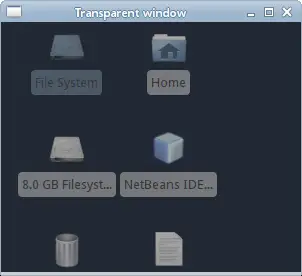Root window
last modified July 17, 2023
In this part of the Cairo graphics tutorial we work with the root window. The root window is the desktop window where we usually have icon shortcuts.
It is possible to manipulate with the root window. From the programmer's perspective, it is just a special kind of a window.
Transparent window
Our first example will create a transparent window. We see what it beneath the window object.
#include <cairo.h>
#include <gtk/gtk.h>
static void do_drawing(cairo_t *);
static void tran_setup(GtkWidget *win)
{
GdkScreen *screen;
GdkVisual *visual;
gtk_widget_set_app_paintable(win, TRUE);
screen = gdk_screen_get_default();
visual = gdk_screen_get_rgba_visual(screen);
if (visual != NULL && gdk_screen_is_composited(screen)) {
gtk_widget_set_visual(win, visual);
}
}
static gboolean on_draw_event(GtkWidget *widget, cairo_t *cr,
gpointer user_data)
{
do_drawing(cr);
return FALSE;
}
static void do_drawing(cairo_t *cr)
{
cairo_set_source_rgba(cr, 0.2, 0.2, 0.2, 0.4);
cairo_set_operator(cr, CAIRO_OPERATOR_SOURCE);
cairo_paint(cr);
}
int main (int argc, char *argv[])
{
GtkWidget *window;
GtkWidget *darea;
gtk_init(&argc, &argv);
window = gtk_window_new(GTK_WINDOW_TOPLEVEL);
tran_setup(window);
darea = gtk_drawing_area_new();
gtk_container_add(GTK_CONTAINER (window), darea);
g_signal_connect(G_OBJECT(darea), "draw",
G_CALLBACK(on_draw_event), NULL);
g_signal_connect(window, "destroy",
G_CALLBACK(gtk_main_quit), NULL);
gtk_window_set_position(GTK_WINDOW(window), GTK_WIN_POS_CENTER);
gtk_window_set_default_size(GTK_WINDOW(window), 300, 250);
gtk_window_set_title(GTK_WINDOW(window), "Transparent window");
gtk_widget_show_all(window);
gtk_main();
return 0;
}
To create a transparent window, we get the visual of the screen object
and set it for our window. In the on_draw method, we draw over the
screen's visual object. This creates an illusion of partial transparency.
gtk_widget_set_app_paintable(win, TRUE);
We must set the application to be painted on.
screen = gdk_screen_get_default();
The gdk_screen_get_default method returns the screen object.
visual = gdk_screen_get_rgba_visual(screen);
From the screen window, we get its visual. The visual contains the low level display information.
if (visual != NULL && gdk_screen_is_composited(screen)) {
gtk_widget_set_visual(win, visual);
}
Not all displays support this operation. Therefore, we check if our screen supports composition and the returned visual is not None. We set the screen's visual to be the visual of our window.
static void do_drawing(cairo_t *cr)
{
cairo_set_source_rgba(cr, 0.2, 0.2, 0.2, 0.4);
cairo_set_operator(cr, CAIRO_OPERATOR_SOURCE);
cairo_paint(cr);
}
We use a partially transparent source to draw over the screen
window. The CAIRO_OPERATOR_SOURCE creates a composition
operation where we draw over the source. Which is the screen window.
To get full transparency, we set the alpha value to 0 or use the
CAIRO_OPERATOR_CLEAR operator.

Taking a screenshot
The root window is also essential in taking a screenshot.
#include <cairo.h>
#include <gdk/gdk.h>
int main (int argc, char *argv[])
{
gdk_init(&argc, &argv);
GdkWindow *root_win = gdk_get_default_root_window();
gint width = gdk_window_get_width(root_win);
gint height = gdk_window_get_height(root_win);
cairo_surface_t *surface = cairo_image_surface_create(CAIRO_FORMAT_ARGB32,
width, height);
GdkPixbuf *pb = gdk_pixbuf_get_from_window(root_win, 0, 0, width, height);
cairo_t *cr = cairo_create(surface);
gdk_cairo_set_source_pixbuf(cr, pb, 0, 0);
cairo_paint(cr);
cairo_surface_write_to_png(surface, "image.png");
cairo_destroy(cr);
cairo_surface_destroy(surface);
return 0;
}
The example captures a snapshot of the entire screen. In this example, we do not use the full GTK windowing system. We use Cairo and GDK libraries to do the job.
gdk_init(&argc, &argv);
The gdk_init initializes the GDK library and connects to
the windowing system.
GdkWindow *root_win = gdk_get_default_root_window();
We get the root window with the gdk_get_default_root_window
function call.
gint width = gdk_window_get_width(root_win); gint height = gdk_window_get_height(root_win);
We determine the width and the height of the root window.
cairo_surface_t *surface = cairo_image_surface_create(CAIRO_FORMAT_ARGB32,
width, height);
An empty image surface is created. It has the size of the root window.
GdkPixbuf *pb = gdk_pixbuf_get_from_window(root_win, 0, 0, width, height);
We get a pixbuf from the root window using the gdk_pixbuf_get_from_window
function call. A pixbuf is an object that describes an image in memory.
cairo_t *cr = cairo_create(surface); gdk_cairo_set_source_pixbuf(cr, pb, 0, 0); cairo_paint(cr);
In the above code lines, we create a Cairo drawing context on the image surface that we have created earlier. We place the pixbuf on the drawing context and paint it on the surface.
cairo_surface_write_to_png(surface, "image.png");
The image surface is written to a PNG image using the
write_to_png method.
cairo_destroy(cr); cairo_surface_destroy(surface);
We clean up resources.
Showing a message
In the third example we show a message on the desktop window.
#include <cairo.h>
#include <gtk/gtk.h>
#include <pango/pango.h>
static void do_drawing(cairo_t *);
static gboolean on_draw_event(GtkWidget *widget, cairo_t *cr,
gpointer user_data)
{
do_drawing(cr);
return FALSE;
}
static void do_drawing(cairo_t *cr)
{
cairo_set_operator(cr, CAIRO_OPERATOR_CLEAR);
cairo_paint(cr);
cairo_set_operator(cr, CAIRO_OPERATOR_OVER);
}
static void setup(GtkWidget *win)
{
gtk_widget_set_app_paintable(win, TRUE);
gtk_window_set_type_hint(GTK_WINDOW(win), GDK_WINDOW_TYPE_HINT_DOCK);
gtk_window_set_keep_below(GTK_WINDOW(win), TRUE);
GdkScreen *screen = gdk_screen_get_default();
GdkVisual *visual = gdk_screen_get_rgba_visual(screen);
if (visual != NULL && gdk_screen_is_composited(screen)) {
gtk_widget_set_visual(win, visual);
}
}
int main (int argc, char *argv[])
{
GtkWidget *window;
GtkWidget *lbl;
gtk_init(&argc, &argv);
window = gtk_window_new(GTK_WINDOW_TOPLEVEL);
setup(window);
lbl = gtk_label_new("ZetCode, tutorials for programmers");
PangoFontDescription *fd = pango_font_description_from_string("Serif 20");
gtk_widget_modify_font(lbl, fd);
gtk_container_add(GTK_CONTAINER(window), lbl);
GdkColor color;
gdk_color_parse("white", &color);
gtk_widget_modify_fg(lbl, GTK_STATE_NORMAL, &color);
g_signal_connect(G_OBJECT(window), "draw",
G_CALLBACK(on_draw_event), NULL);
g_signal_connect(window, "destroy",
G_CALLBACK(gtk_main_quit), NULL);
gtk_window_set_position(GTK_WINDOW(window), GTK_WIN_POS_CENTER);
gtk_window_set_default_size(GTK_WINDOW(window), 350, 250);
gtk_widget_show_all(window);
gtk_main();
return 0;
}
The code displays a message label on the root window.
static void do_drawing(cairo_t *cr)
{
cairo_set_operator(cr, CAIRO_OPERATOR_CLEAR);
cairo_paint(cr);
cairo_set_operator(cr, CAIRO_OPERATOR_OVER);
}
We use the CAIRO_OPERATOR_CLEAR operator to clear
the background of the window. Then we set the CAIRO_OPERATOR_OVER
to let the label widget be drawn.
gtk_widget_set_app_paintable(win, TRUE);
We will be manipulating the application window, so we make it paintable.
gtk_window_set_type_hint(GTK_WINDOW(win), GDK_WINDOW_TYPE_HINT_DOCK);
Implementing this window hint removes window borders and decoration.
gtk_window_set_keep_below(GTK_WINDOW(win), TRUE);
We keep the application always at the bottom, just over the root window.
GdkScreen *screen = gdk_screen_get_default();
GdkVisual *visual = gdk_screen_get_rgba_visual(screen);
if (visual != NULL && gdk_screen_is_composited(screen)) {
gtk_widget_set_visual(win, visual);
}
We set the visual of the screen to be the visual of our application.
lbl = gtk_label_new("ZetCode, tutorials for programmers");
We create a message label.
PangoFontDescription *fd = pango_font_description_from_string("Serif 20");
gtk_widget_modify_font(lbl, fd);
With the help of the Pango module, we select a specific font for the text.
gtk_container_add(GTK_CONTAINER(window), lbl);
The label is put onto the window.
GdkColor color;
gdk_color_parse("white", &color);
gtk_widget_modify_fg(lbl, GTK_STATE_NORMAL, &color);
We modify the text to be in white colour.

In this chapter we have worked with the desktop window in Cairo.